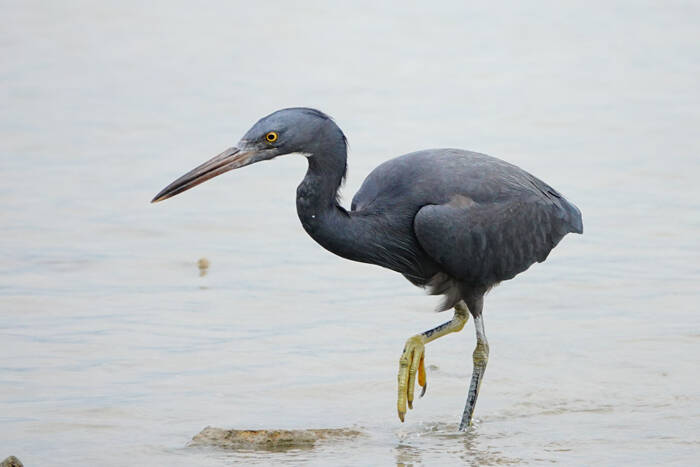Egretta sacra
IUCN
LCBasic Information
Scientific classification
- name:Egretta sacra
- Scientific Name:Egretta sacra,Pacific Reef-egret,Pacific Reef Heron, Eastern Reef Egret
- Outline:Wading birds
- Family:Ciconiiformes Ardeidae Egretta
Vital signs
- length:60-75cm
- Weight:330-700g
- lifetime:About 10-20 years
Feature
Strong territorial awareness
Distribution and Habitat
Distributed in Australia, Bangladesh, Brunei Darussalam, Cambodia, China, Christmas Island, Cocos (Keeling) Islands, Fiji, French Polynesia, Guam, India, Indonesia, Japan, Democratic People's Republic of Korea, Republic of Korea, Malaysia, Marshall Islands, Federated States of Micronesia, Myanmar, New Caledonia, New Zealand, Northern Mariana Islands, Palau, Papua New Guinea, Philippines, Singapore, Solomon Islands, Thailand, East Timor, Tonga, Vietnam.
Wandering: Nauru.
The rock heron is a typical coastal bird and a resident bird. It mainly lives on islands and coastal coasts in tropical and subtropical oceans, especially on rocky islands and coastal rocks. It lives in mangroves, mudflats, beaches, tidal rivers and streams along the coast, and tends to avoid sandy coasts or those with steep cliffs.
Although primarily a coastal species, the Rock Heron sometimes ventures slightly inland, where it may inhabit shallow flats, lakesides, and fields far from the coast.
Appearance
Body length 60-75 cm, mouth length 70-86 mm, wingspan 25-30 mm, tail length 91-98 mm, tarsometatarsus 72-77 mm; weight 330-700 grams. The mouth is long and blunt, the neck is long, the legs are thick and short, and the body color is white and black.
The feathers of the white type are pure white, the exposed skin on the face is yellow-green, the eyes and mouth are usually yellow, the feet are yellow-green, and the toes are yellow. During breeding, there are long lanceolate ornaments on the back of the head and the lower part of the front neck. There are long feathers on the back, but they only reach the base of the tail feathers. The feathers on the head, back and front neck disappear in winter. It is difficult to distinguish it from egrets and yellow-billed egrets whose body feathers are also white. Only the bill is relatively thick and tapering until the tip. It does not gradually become thinner and pointed like the egret or yellow-billed egret. In addition, they There are two main
Details
Pacific Reef-egret is a medium-sized wading bird with two subspecies.

Pacific Reef-egret is a species with a high sense of territory. Most of them move alone, sometimes in pairs or in small groups as a family unit, occupying a small reef or coast. It usually only appears on rocky shores, often standing on rocks by the sea or leaping between waves, flying close to the sea surface. It only wanders around occasionally during the non-breeding season, which is one of the differences between it and other herons in terms of habits. It is mostly active during the day, but more active at dusk. It is shy, solitary and quiet, and not easy to approach. Except for the breeding season, it often moves alone, mostly quietly foraging on the rocks along the coast or walking slowly, and sometimes standing on the more hidden rocks by the water, with a hunchbacked body, standing still for a long time. It is usually very cautious when moving, often moving and foraging gently and silently. Sometimes it also flies low in the sky between the rocks and waves, and its neck shrinks into an "S" shape when flying, and its wings flap slowly, calmly and without panic. But when it is threatened, it can also fly quite fast.
Rock herons usually hunt in a slow, moving footsteps, with a distinctive deep crouching posture, periodically standing and standing upright to scan for prey, or quickly chasing after prey. They will also stir the water with their feet to disturb potential prey, and sometimes search or search under leaves on the shore. Some studies have shown that the two color forms of rock herons may have slight differences in their habitat selection and feeding behavior. They feed during the day and at night, and their feeding time depends on the tide. When food is abundant, they may occasionally feed in groups, and may also live in small groups at night, sometimes mixed with other species. The diet mainly consists of small fish and crabs, and also eats insects, mollusks and even lizards, and also eats bird eggs.
The breeding season is April-June. Nesting in the crevices and platforms of island rock walls, or in trees or low shrubs. Usually nesting in groups and scattered on rocks on islands. The nest is simple, made of dead branches and grass stems in a disc shape. Each nest lays 2 to 5 eggs, which are light blue or light green and measure 42-48 mm × 32-35 mm.
The rock heron is not in danger of extinction because they have a large and widespread species population, and this population is not considered to be in decline. However, in southern Australia, Tasmania and New Zealand, the population may have experienced some local declines. Potential threats to the rock heron include human disturbance, including habitat fragmentation, ship traffic and the impact of climate change.
Listed in the IUCN Red List of Threatened Species in 2018 ver 3.1-Least Concern (LC).
Listed in China's "National Key Protected Wildlife List" (February 5, 2021) Level 2.
Protect wildlife and eliminate game.
Maintaining ecological balance is everyone's responsibility!








